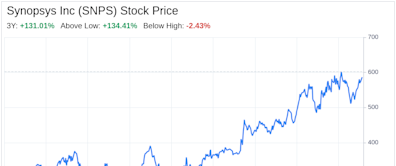- SNPS +0.19%
Search results
- 587.40Add to watchlist+1.10 (+0.19%)At close: Fri. May 24, 2024 4:00 PM EDT · Nasdaq Real Time Price (USD) · Market closed
- Open582.90High594.61Low580.07
- Mkt Cap90BP/E (TTM)64.13Div & YieldN/A & N/A
- Prev. Close586.3052 Wk. Low416.8752 Wk. High629.38
What analysts are sayingTop storiesDecoding Synopsys Inc (SNPS): A Strategic SWOT InsightYahoo Finance · 18 hours ago- SNPS +0.19%
We Like These Underlying Return On Capital Trends At Synopsys (NASDAQ:SNPS)Yahoo Finance · 2 days agoSynopsys (SNPS) Q2 Earnings and Revenues Lag EstimatesYahoo Finance · 3 days agoRelated stocks
Find the latest Synopsys, Inc. (SNPS) stock quote, history, news and other vital information to help you with your stock trading and investing.
- Overview
- For more information about SNPs:
- Topics in the Genomic Research chapter
- GeneratedCaptionsTabForHeroSec
Single nucleotide polymorphisms, frequently called SNPs (pronounced “snips”), are the most common type of genetic variation among people. Each SNP represents a difference in a single DNA building block, called a nucleotide. For example, a SNP may replace the nucleotide cytosine (C) with the nucleotide thymine (T) in a certain stretch of DNA.
SNPs occur normally throughout a person’s DNA. They occur almost once in every 1,000 nucleotides on average, which means there are roughly 4 to 5 million SNPs in a person's genome. These variations occur in many individuals; to be classified as a SNP, a variant is found in at least 1 percent of the population. Scientists have found more than 600 million SNPs in populations around the world.
Most commonly, SNPs are found in the DNA between genes. They can act as biological markers, helping scientists locate genes that are associated with disease. When SNPs occur within a gene or in a regulatory region near a gene, they may play a more direct role in disease by affecting the gene’s function.
Most SNPs have no effect on health or development. Some of these genetic differences, however, have proven to be very important in the study of human health. SNPs help predict an individual’s response to certain drugs, susceptibility to environmental factors such as toxins, and risk of developing diseases. SNPs can also be used to track the inheritance of disease-associated genetic variants within families. Research is ongoing to identify SNPs associated with complex diseases such as heart disease, diabetes, and cancer.
An audio definition of SNPs is available from the National Human Genome Research Institute’s Talking Glossary of Genetic Terms.
How scientists locate SNPs in the genome is explained by the University of Utah Genetic Science Learning Center.
•What are single nucleotide polymorphisms (SNPs)?
•What are genome-wide association studies?
•What is pharmacogenomics?
•What are genome editing and CRISPR-Cas9?
Other chapters in Help Me Understand Genetics
The information on this site should not be used as a substitute for professional medical care or advice. Contact a health care provider if you have questions about your health.
SNPs are single nucleotide differences in DNA that occur normally and frequently in the population. They can be used as markers to locate disease genes, predict drug response, and track inheritance patterns.
In genetics and bioinformatics, a single-nucleotide polymorphism (SNP / s n ɪ p /; plural SNPs / s n ɪ p s /) is a germline substitution of a single nucleotide at a specific position in the genome. Although certain definitions require the substitution to be present in a sufficiently large fraction of the population (e.g. 1% or more), [1] many ...
5 days ago · Definition. 00:00. …. A single nucleotide polymorphism (abbreviated SNP, pronounced snip) is a genomic variant at a single base position in the DNA. Scientists study if and how SNPs in a genome influence health, disease, drug response and other traits.
People also ask
How are SNPs used in basic genetics research?
How many SNPs are there in a human genome?
What happens if a SNP occurs within a gene?
Is the genomic distribution of SNPs homogenous?
May 9, 2024 · Learn about SNPs, variations in DNA sequence that occur in more than 1 percent of a population and can affect health and disease. Find out how SNPs are used for genetic mapping, diagnosis, and personalized medicine.
- The Editors of Encyclopaedia Britannica
A single nucleotide polymorphism, or SNP, is a single base-pair difference in the DNA sequence of individual members of a species; not necessarily a pathological mutation, but commonly studied as...
SNPs are variations in the DNA sequence at particular locations, caused by copying errors during cell division. They can influence traits, disease susceptibility, or genetic similarity between people.



